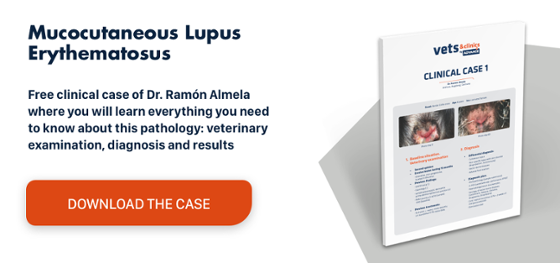Pemphigus foliaceus in dogs
The pemphigus complex is a group of an autoimmune disease of the skin, whose nature varies from vesiculobullous/pustular to erosive/ulcerative.3 Five forms of presentation have been described:3,4
- Pemphigus foliaceus (PF).
- Pemphigus erythematosus (PE).
- Panepidermal pustular pemphigus (PPP).
- Pemphigus vulgaris (PV).
- Paraneoplastic pemphigus (PNP).
Pemphigus foliaceus is the most common form of presentation in dogs and cats.4 It may appear spontaneously, in relation to drug administration, or associated with the presence of neoplastic skin diseases.1
Pathogenesis
The epidermis is composed of strongly adhered keratinocytes, which act as a protective barrier against the adverse effects of the external environment. The structures that provide this intercellular adhesion are called desmosomes.3
All forms of pemphigus course with the presence of autoantibodies that act against proteins found in the keratinocyte desmosomes. This results in a loss of intercellular adhesion and therefore spaces form between the keratinocytes.1,3
The damaging mechanisms in this disease are not precisely understood, but studies indicate that the antibodies have a fundamental pathogenic role, as they initiate different signalling cascades that cause keratinocyte acantholysis (loss of adhesion between the keratinocytes within the epidermis) and apoptosis.5
Some studies have described a degree of predisposition to PF in certain breeds, mainly in the Akita and Chow Chow, but with independence of sex.3 The onset of PF in these two breeds is usually idiopathic.4 In terms of age, middle-aged dogs tend to be the most affected.3
Clinical signs
Clinical lesions are variable and range from vesicles and pustules, scabs, abrasions and ulcers to alopecia.4
If the altered bonds are between superficial keratinocytes, then vesicles and pustules will develop. In the case of PF, intraepidermal and intrafollicular pustules are frequently observed. If, on the other hand, the bonds between the deep keratinocytes and the basal membrane are affected, blisters and ulcers will be observed. The appearance of hair shafts emerging from the pustules is also common.3
However, the clinical signs vary depending on breed, triggering factors and the cyclical nature of the disease itself. In some cases the lesions are focused on the head, face and outer ear, while in others they are more generalised and additional systemic symptoms develop, such as fever, lethargy, pruritus and oedema in the limbs.4 In can also develop on the paw pads with clear signs of erythema and hyperkeratosis.3
Diagnosis
The differential diagnosis of pemphigus foliaceus in dogs, based on clinical findings, should include superficial folliculitis, dermatophytosis, demodicosis, discoid lupus erythematosus and pemphigus erythematosus.1
The diagnosis initially requires a complete medical history and an appropriate physical examination, with an emphasis on pustules or vesicles with marked acantholysis of the keratinocytes.3
Cytology can significantly help in the diagnosis of PF if it reveals the presence of acantholytic cells. A blood count shows changes in cell counts, usually from mild to marked leukocytosis and neutrophilia, moderate nonregenerative anaemia, moderate hypoalbuminaemia and slightly elevated globulins.4
The definitive diagnosis is based on histopathological findings, which include a high density of acantholytic cells and the presence of large pustules that span multiple hair follicles.1
Other techniques such as direct immunofluorescence or immunoperoxidase can also help detect antikeratinocyte autoantibodies directly from the skin of dogs with PF.3 The intercellular autoantibodies typically found in the epidermis are IgG and, to a lesser extent, IgA and IgM. However, immunopathology results must always be correlated with clinical and histopathological findings.4
Treatment
All forms of pemphigus require immunosuppressive or immunomodulatory therapies.4 After being used for over three decades in the treatment of dogs with PF,glucocorticoids are still the most common therapeutic intervention.2
The oral glucocorticoid of choice depends on the individual response of each dog and any adverse effects it may suffer. Prednisone or prednisolone is usually chosen at immunosuppressive doses, although methylprednisolone, triamcinolone and dexamethasone can also be used.4 The initial adverse effects of glucocorticoids include polyuria, polydipsia and polyphagia. Long-term treatment can lead to the onset of skin atrophy, gastric ulcers, liver disease, diabetes mellitus, calcinosis cutis, and secondary infections, usually bacterial. Furthermore, glucocorticoids in monotherapy only provide effective management in 35–50% of dogs with PF.3
Glucocorticoids can be used in combination with cytotoxic drugs such as azathioprine, chlorambucil or cyclophosphamide.3 In fact, the treatment of choice for PF in many cases is the combination of azathioprine and glucocorticoid, or prednisone monotherapy.1 Other options include mycophenolate mofetil or a combination of tetracycline and niacinamide.6
In recent years, glycosaminoglycans (GAGs) have also been described as a novel immunomodulatory therapy, thanks to the discovery of their in vitro anti-inflammatory and immunomodulatory properties.7
The chronic and recurrent nature of pemphigus foliaceus represents a major challenge for the veterinary community.3

